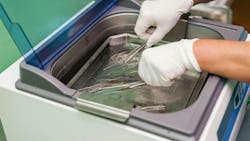Q: “We have a tabletop ultrasonic cleaner that we must manually fill. My teammate told me if we fill it ¾ full we get more cleaning power. Is that true?”
A:
Less is not more. Ultrasonic cleaners are fine-tuned for a particular fill level; underfilling the tank will not increase cleaning power. Rather, it can damage the unit and result in less-than-optimal cleaning.
To further your knowledge on this topic, I would recommend reading some great articles that deal with the importance of watts/gallon and how it correlates to ultrasonic cleaning.1
Q: “I have heard that ultrasonic cleaners must be at a specific frequency for many medical devices. Is that true? How do I know what frequency my unit is (it is over 15 years old)?”
A:
Finding your frequency should be easy. Many units have it labeled. If you cannot find it, just call the manufacturer and ask them for that information on their letterhead for your records.
Interestingly, ultrasonic units in SPD do have specific range, and it is based on research.
Published literature states, “. . . to cavitate a liquid medium, a frequency of 18 kHz is required. Ultrasonic cleaners are available in frequencies ranging from 18 to 100 kHz.”2 Other articles suggest that for metal cleaning a frequency range of 20–40 kHz is needed for proper cleaning. In an SPD, we clean many different types of metal medical devices. “Ultrasonic cleaning frequency has a significant effect with respect to ultrasonic cleaning capability. Ultrasonic cleaning equipment manufacturers state that low frequency cleaners provide high power cleaning results and that a high-frequency cleaner provides more uniform cleaning results. Our study indicated that ultrasonic cleaners in the range of 40 kHz provide very uniform ultrasonic cleaning fields and a higher cleaning capability.”3 Thus, my observation over the years has shown most ultrasonics in the SPD marketplace to be in that 40 kHz range. Once you know the frequency of your department’s ultrasonic unit, you can then make sure it can be used for your various medical devices (based on their IFU). Thus, what I call the “matching game” begins.
Q: “We ran out of our ultrasonic cleaning solution and my co-worker said to ‘Use anything we have; they all work the same.’ Can you explain why that is not a correct statement?”
A:
As stated earlier, in an SPD, we clean many different metal medical devices. We purchase ultrasonic cleaners for cavitation, and you want to enhance cavitation any time you can. One way to do this is by using cleaning solutions formulated for ultrasonic cleaners. First, cleaning solutions can lower the surface tension inside the tank or bath solution, which can then increase cavitation within that tank/bath. Second, you want a low-foaming cleaning solution—foaming or bubbles are air, and air can impede or reduce cavitation in that tank/bath.4,5
As a bonus answer, since air impedes or inhibits cavitation, this supports the concept of degassing. Degassing is a process which eliminates air trapped in solution when fresh solution is added to the bath. Degassing conditions your bath for maximum efficiency. Be sure to expel dissolved air bubbles, as these bubbles will affect the cleaning effectiveness.
It’s about ensuring enough cavitation to “keep those instruments clean.” Remember to test your ultrasonic cleaner each day it is used with a clinically relevant, evidence-based product. For example, as stated in a peer-reviewed article, the “SonoCheck is a vial with a solution that changes color within a few minutes due to ultrasound exposure, and can therefore be used as an ultrasonic activity indicator.”6
References (APA Style 7th Edition):
-
John’s Corner (Fuchs, J.). (2013, January 22). Ultrasonics – Ultrasonic Power Density vs. Tank Size. PDF: Understanding Ultrasonic Power Requirements Based on Tank Size and Other Factors. https://techblog.ctgclean.com/wp-content/uploads/Considerations-for-Ultrasonic-Power-Density-vs.-Tank-Volume1.pdf. Cleaning Technologies Group. https://techblog.ctgclean.com/2013/01/ultrasonics-ultrasonic-power-density-vs-tank-size/
-
U.S. Army. (Last accessed 2004, February 10). Background on Ultrasonic and Aqueous Cleaning. http://aec.army.rnil/usaec/technology/p2compliance10.html. (No longer cached online.)
-
Gillespie, T.J. (1980, May 8–10). (GEPP-OP-501) Evaluation of Ultrasonic Cleaning Systems. p15. General Electric Co., Neutron Devices Department. St. Petersburg, FL. CONF-800538-3. From ACS 1980 Meeting-in-Miniature; Tampa, FL.
-
Upcorp. (n.d.). Basic Concerns with Ultrasonic Cleaning | Part 3: Cleaning Fluid. Ultrasonic Power Corporation. https://www.upcorp.com/blog/basic-concerns-with-ultrasonic-cleaning-part-3-cleaning-fluid/
-
Sandor, B. (2023, September 28). Ultrasonic Cleaner Degas: Why it’s Important. Tovatech. https://tovatech.com/blog/399/ultrasonic-cleaner/how-to-degas-ultrasonic-cleaner-solution#:~:text=Bubbles%20and%20dissolved%20air%20in,of%20an%20ultrasonic%20cleaning%20tank
-
Verhaagen, B., Fernández-Rivas, D. (2016). Measuring cavitation and its cleaning effect. Ultrasonics Sonochemistry, 29(2016), 619–628. https://www.sciencedirect.com/science/article/pii/S1350417715000723/pdfft?md5=b21635f90f2af9beb7767b5a262d1b47&pid=1-s2.0-S1350417715000723-main.pdf
About the Author

Stephen M. Kovach
Stephen M Kovach, BS, CFER, started in the medical field in 1975 as a sterilization orderly and has worked in many positions within the Healthcare Industry. He presently is Clinical Educator Emeritus at Healthmark, A Getinge company.
